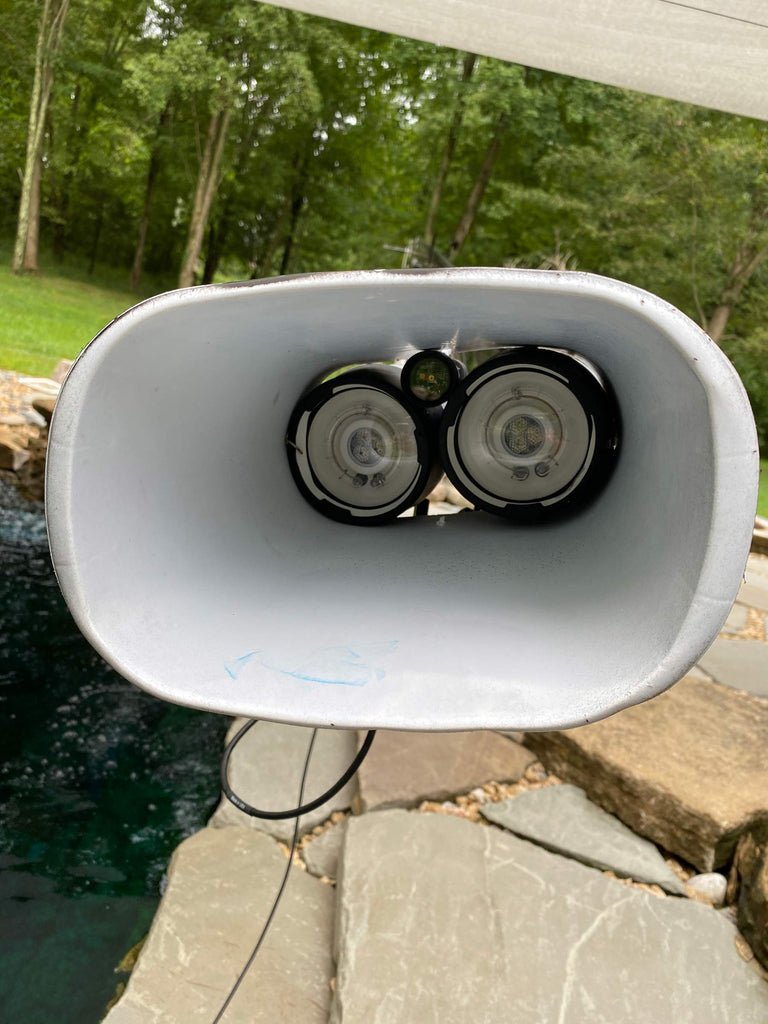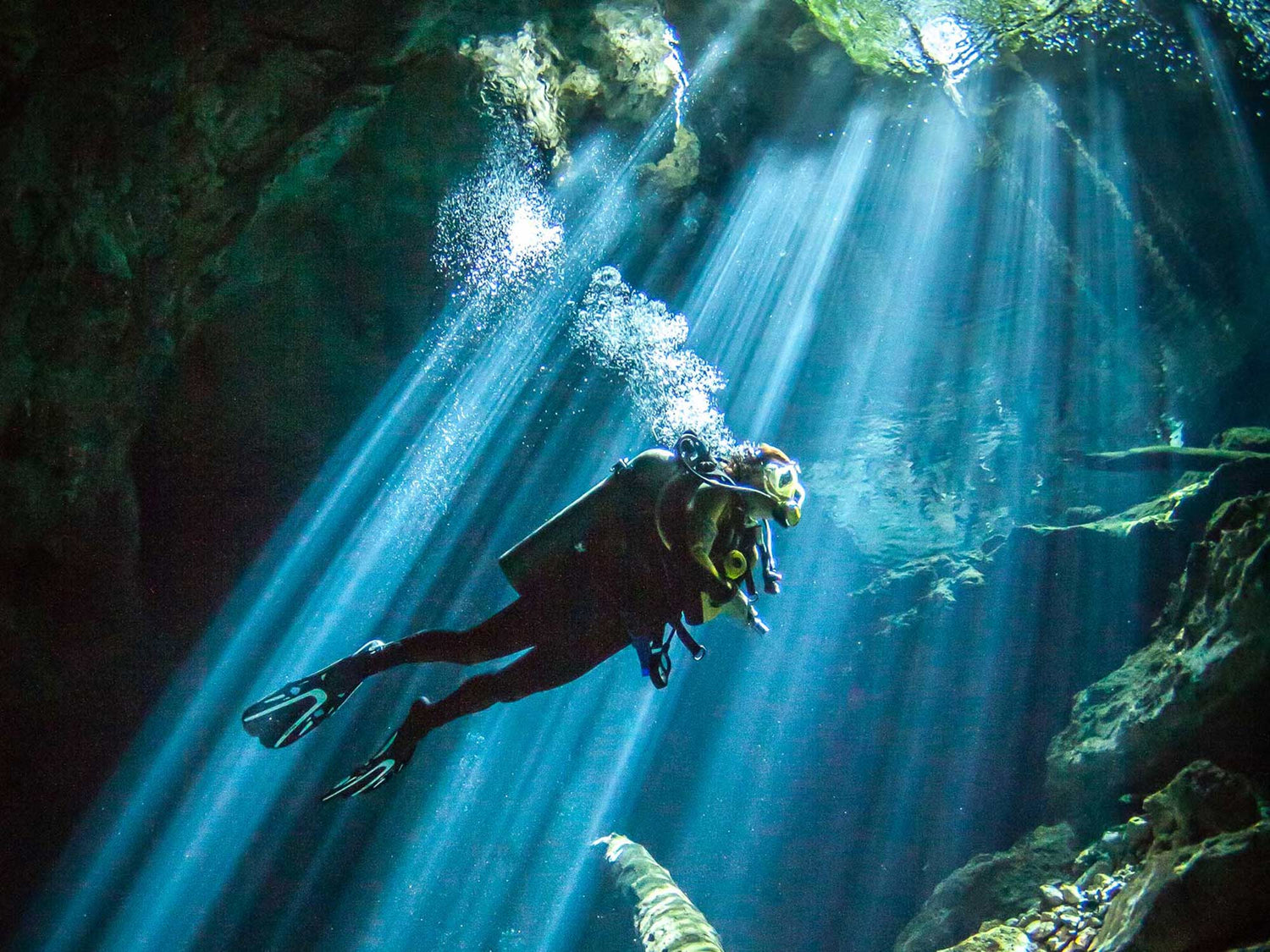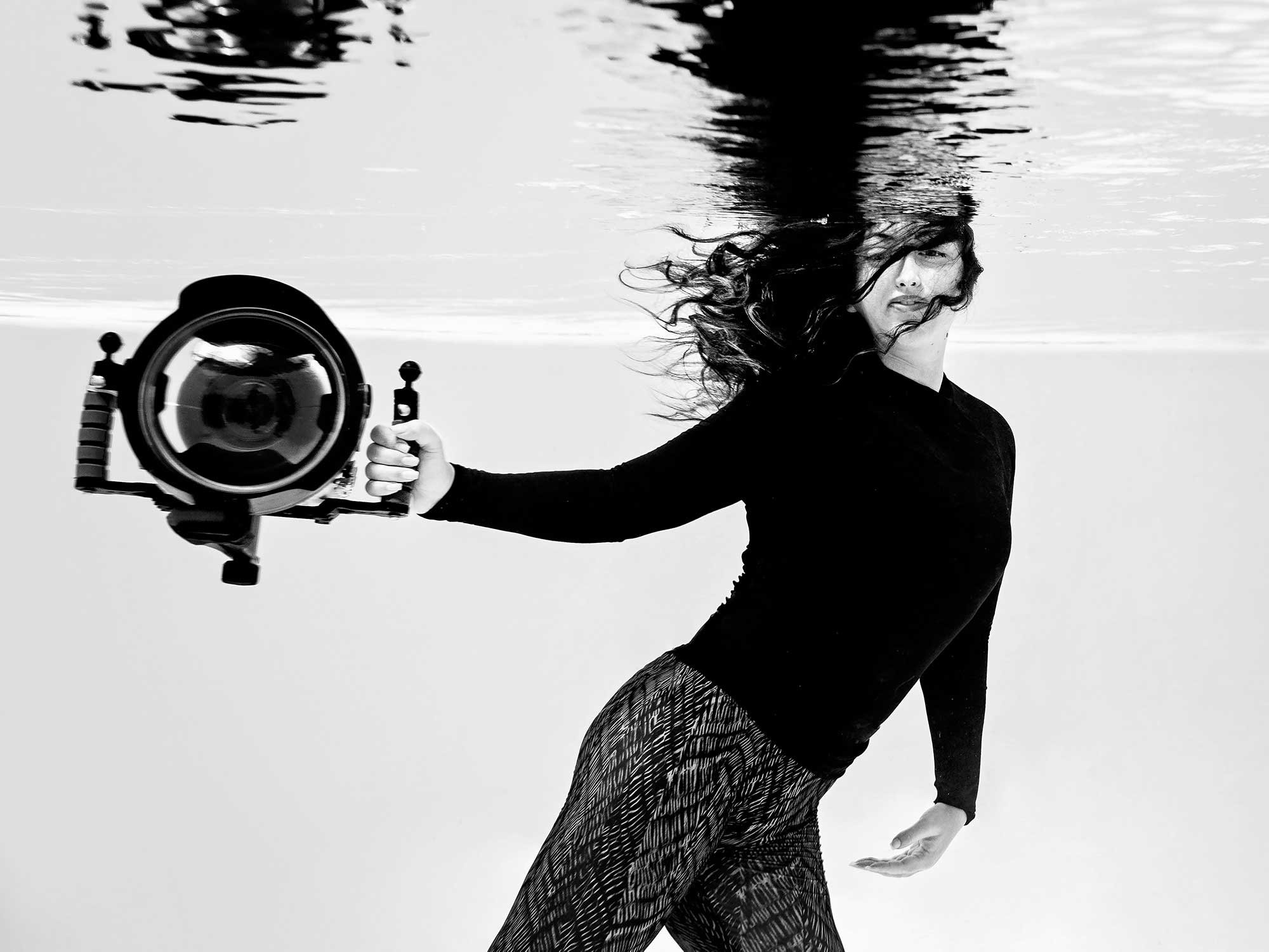By Steve Miller
We all love light rays in our images. We chase them. Topside photographers don't see these rays as often as we do underwater, but sometimes fog, smoke, or the perfect cloud can create nice rays.
Recently an underwater photographer working in pools with models asked me if we knew any tricks to create light rays in her pool images. This got me thinking. The short answer was no. I mostly just shoot them when I see them and then enhance them in post with contrast and clarity.
But create them? How? Why are light rays sometimes there, and sometimes not?

Misty Morning fog light rays. The fog gives this light something to reflect off of, or illuminate, similar to the turbidity of even the clearest water. As you move the highlight around in your frame you will see these rays form, especially when you block some of the light source with something solid, like a tree. © 2021 Steve Miller

Cenote Light. These rays will only occur with this orientation or angle during a precise time in the afternoon when the overhead sun orients itself to the entrance of the cave. Divers must time their entry to be in position with plenty of air when they form. © 2021 Steve Miller
Most underwater photographers I know try to capture light rays whenever they stumble on them. They often disappear and reappear as we focus on our primary subject. I wasn't aware of any "formula" being applied. Is it the angle of the camera lens? The sun? The angles of these elements and the surface of the water combined?
Google led me down a rabbit hole of the laws of physics and properties of light. Refraction, diffraction, dispersion, reflection (diffuse or specular), and eventually waves and photons. I wasn't ready for quantum theory so I decided it would be easier to look at images with nice rays in them, try to figure out what was going on, and then try to reproduce it in the studio pool with both natural light and strobes.
Rays, Three Ways
Upon looking through many images it seems there are at least three distinctly different types of light rays to be found.
1 | Aim for the Light
The first type of light ray is the most common, and easiest to find and capture. These rays are produced when we shoot directly into the sun or a bright highlight. An upward camera angle with a super wide lens will often have the sun in the frame. This will usually produce some rays. A radial pattern will appear pretty consistently. The fact that you are shooting into a light source probably means you have closed down the aperture (larger f/number). That will help accentuate the rays.

Radial light rays from shooting directly into the sun are the easiest to find. Stop the lens down and use a fast shutter to freeze them. Many photographers will collect images like these for compositing later. If you see beautiful light -- shoot it! © 2021 Steve Miller
2 | Block the Light
The second type that I found a lot of are an entirely different kind of light ray. They are opposite, in a sense, to the radial rays of the sun or a highlight, because they are created when you look down. In this case, your body is a solid “light blocking” object that creates the beams as the light spills around you, seeming to converge at your shadow. Look closely at the image below and you will see two legs with fins at the bottom, slightly silhouetted.
These rays will follow you around, but may disappear when the sun goes behind a cloud. When an object blocks the light, the light bends around it slightly. This is known as diffraction.

Look straight down for these rays - you make them with your body! © 2021 Steve Miller
3 | In the Ether
The third type of light ray are the most highly sought after. These rays are not created or enhanced by a light blocking object like the dive boat, or a fish, or your body, but they exist nonetheless. These rays are created by the surface chop of the ocean or any disturbance on the water's surface, which is the transition plane for the light passing from air to water. The angle of the water in the swell bends the light passing through it, and not uniformly. This is refraction, when light bends quickly as it moves through different mediums, e.g. from air to water.

The swimmers, floating seaweed, surface chop, and the Whaleshark itself are all creating rays here. © 2021 Steve Miller

You can see that these rays are emanating from around the snorkelers body, the dark center is the shadow. The patterning of light on the fish's back is a different phenomena, refracting light from the surface chop. © 2021 Steve Miller
Harnessing the Light
Divers call the hour before dusk the "Golden Hour" because the sky is often colored by the low sun. This is the time to find and shoot these ethereal rays.
Try capturing your image while the sun is in full view, with nothing to create a shade line, that emphasizes beams. This tactic can also be accomplished with a strobe if you aren't too deep.
Using an object to block the main light source and capturing the beams that spill over the sides is a classic method going back to film days. Small apertures will help intensify these rays as well.

Golden hour rays are most common at dusk when the sun is low. I shot this as an exposure test while waiting for Oceanic whitetip sharks to show up, and saved it just for the exposure data. I have since used it many times in composites, even of topside images. © 2021 Steve Miller

Dappled light near dusk will refract from the surface chop to break the light into ray patterns that are random and change as they move and dance with the waves. © 2021 Steve Miller

Ever watch your shadow disappear as clouds roll by? These clouds can do the same thing to your light rays - soften or eliminate them from your image. © 2021 Steve Miller

If we were above, or level with this shark, we may see the other types of light rays. Here the strobe has obliterated them leaving us with the radial pattern from the highlight only. © 2021 Steve Miller

Caves and cenotes are natural light blockers. © 2021 Steve Miller

Some rays move around, or dance, from the surface chop. If you want to freeze, them a fast shutter speed will help but letting them go creamy with a slow shutter can be nice too. © 2021 Steve Miller
Manufacturing Magic
The question still remains -- how can I create, and control, my own light rays in a studio setup like a pool?
The easiest place to start is to create simple radial rays that come from a strong light source. A strobe or two are certainly capable of creating the intensity needed for this, with one caveat: they must be out of the water. Water is the great diffuser, and diffusion is your enemy here.
For my tests, done from my backyard underwater photo studio, I had to use a 20 foot (6 m) cord leading from the housing to a DS161 strobe set on full power. I rigged this setup on a light stand about 8 feet (2.5 m) out of the water.
Inevitably I added a second strobe, slaved with our Optical Slave Converter. The side-by-side strobes were "snooted" using a DIY wastebasket with the bottom cut out. I found that the radial beams that come from a strobe can look exactly like a sun ball. In reviewing my images the only way I could be sure the highlight wasn’t the sun was to place it in the middle of our house. But, these rays just aren’t as exciting as what we can get from the sun.

A pole allows you to shoot without disturbing the visibility. At night, the preview screen is easy to see from the pool deck, even submerged. © 2021 Steve Miller

Ideally, have one person work the camera and another on the lights. © 2021 Steve Miller
There is a brief time in the late afternoon when the sun goes behind the house and if it is a bright, cloudless day decent light rays will be produced. By this point I was convinced that the angle of the lens and the orientation of the light was key because I had watched rays form, disappear, and reappear. Now I'm not so sure it matters. Swimming in circles didn't have a great effect, but if a cloud drifted by the rays disappeared.

After a lot of experimenting, the best naturally occurring light rays I could image were at 3:45pm and only lasted for about 15 minutes as the sun goes behind the house. © 2021 Steve Miller

Two strobes on full power can light the whole pool. A wastebasket functions as a snoot to limit the spread. © 2021 Steve Miller
My favorite solution was to shoot at night with the strobes mounted on a boom pointing down into the water. This maximized the tonal range from dark to light. Two strobes on high power with my DIY wastebasket snoot (commercial snoots seemed to cut out too much light) produced decent light rays, but they were sharpest when I used something to block the light. In this case I used a hula hoop that kept some floating plants in an area where the lights pointed.

The paddlefish seems unimpressed by the work that went into the hula hoop barge and wastebasket sun set-up. © 2021 Steve Miller
Rays, Reused
If you're not against Photoshop magic, once you have images of light rays in your library you can layer them on top of images for a very different look. You will recognize the rays added to these three images from the originals above.

Light rays added to a photo of a dolphin pod swimming by. © 2021 Steve Miller

Ocean light rays added to a Cincinnati street scene. © 2021 Steve Miller

Light rays added to emphasize the meeting between the shark and the diver. © 2021 Steve Miller
Progress Not Perfection
Light rays still baffle me. After 1000 images at all times of day and night for over a month, the only things I know for sure about light rays is that sometimes they are there, and some times they aren’t.
Extreme variances in the tonal range of the scene always help. Starting with as much light as you can get and blocking it with a solid object is the best shortcut I found for creating rays on my own. Do they depend on the orientation of all the optical elements? Yes, to an extent. But, changing the tilt of any particular element doesn’t make them magically come and go.

A piece of foam with light holes cut in it will produce the extreme darks and highlights we are looking for. © 2021 Steve Miller
Conclusion
My key takeaways: the best light rays are made by the sun. But you can make them with a strobe, particularly at night. To my surprise, turbidity isn’t necessary. The clearer your water the farther your light (and rays) will go.
Light bends when it passes through mediums of different density, and it also bends around solid objects. If the angles are right you can use this to make rays... or happily find them.
 Ambassador Steve Miller has been a passionate teacher of underwater photography since 1980. In addition to creating aspirational photos as an ambassador, he leads the Ikelite Photo School, conducts equipment testing, contributes content and photography, represents us at dive shows and events, provides one-on-one photo advice to customers, and participates in product research and development. Steve also works as a Guest Experience Manager for the Wakatobi Dive Resort in Indonesia. In his "free" time he busies himself tweaking his very own Backyard Underwater Photo Studio which he's built for testing equipment and techniques. Read more...
Ambassador Steve Miller has been a passionate teacher of underwater photography since 1980. In addition to creating aspirational photos as an ambassador, he leads the Ikelite Photo School, conducts equipment testing, contributes content and photography, represents us at dive shows and events, provides one-on-one photo advice to customers, and participates in product research and development. Steve also works as a Guest Experience Manager for the Wakatobi Dive Resort in Indonesia. In his "free" time he busies himself tweaking his very own Backyard Underwater Photo Studio which he's built for testing equipment and techniques. Read more...
Additional Reading
Streaming Light Rays Underwater Camera Settings
When to Change Shutter Speed Underwater
4 Creative Uses for Backscatter in Underwater Images
Tiny Scenes | Building an Underwater Still Life in Miniature
Natural Light Photography Underwater
Snell's Window: A Wide Angle Photography Effect
Caverns and Cenotes Underwater Camera Settings













![Underwater Photo Editing: Trash to Treasure Using Lightroom [VIDEO]](http://www.ikelite.com/cdn/shop/articles/steve-miller-trash-to-treasure-cover-photo.jpg?v=1645884668&width=2000)